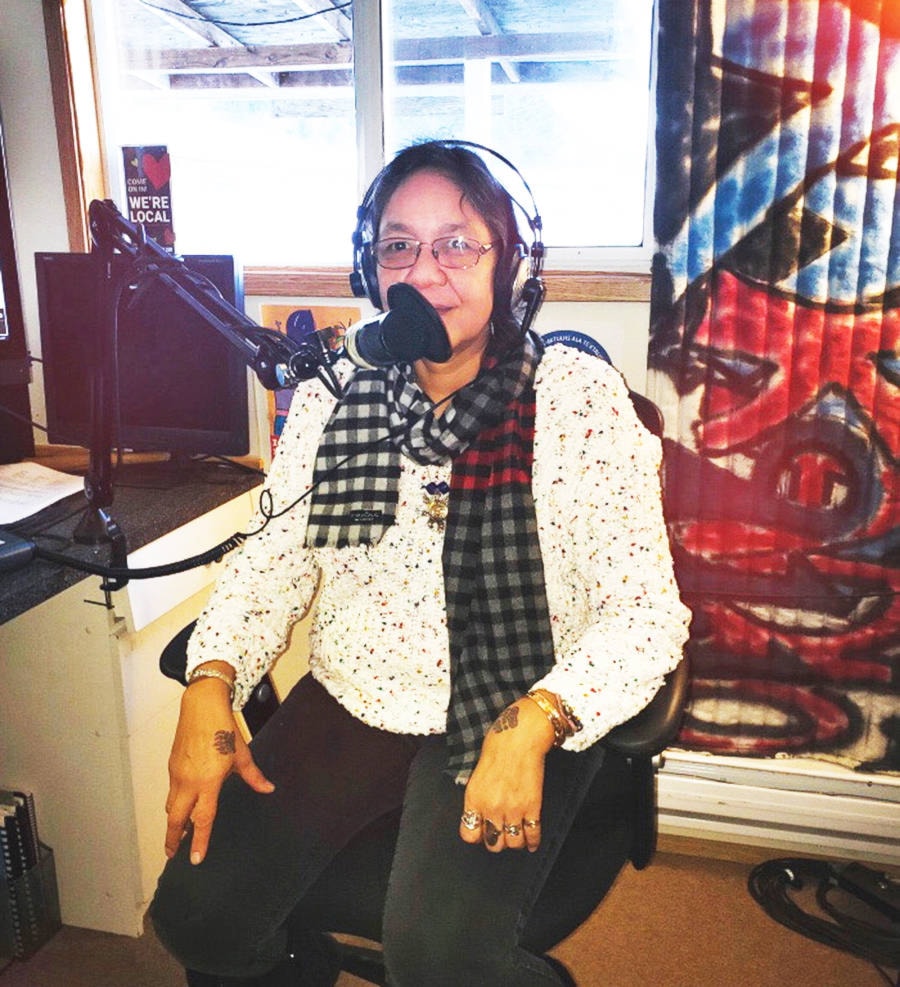Marlene King, 53, grew up speaking the Nuxalk language of her ancestors, a language that is now teetering on the brink of extinction, with only half a dozen fluent speakers left and the majority of them elders over 65.
“Nuxalk was all that was spoken in my household when I was a child,” she said. “It was my first language and I spoke it fluently until I was five years old.”
Today King, whose Nuxalk name is Nuq’aytsulhaqws, can remember numerous words and phrases in Nuxalk, but the ability to speak it in conversation has been lost in the depths of her subconscious.
“I know it’s in there,” she said. “The more I speak and practice the more I find it coming back. My goal is to be fluent in five years.”
King, a Cultural Advisor at Nuxalk College, is part of a larger group of dedicated individuals who are determined to bring back the language. The College runs weekly language classes for elders, and has just come into possession of a large number of recordings of Nuxalk speakers that were taken in 1967-68. King describes the tapes as “immaculate,” and is rightfully ecstatic about receiving them.
“We received 62 tapes and we have never heard them before,” said King. “I was just a year old when these were recorded, so I’m really excited about the knowledge they contain.”
The recordings were done by linguists Ross Saunders of SFU and Phillip Davis of Rice University in Houston, Texas. Saunders passed away in 2005, and his obituary details his 40 years of of study of the Nuxalk language. He started his research in 1966, and developed a Nuxalk-English dictionary in database form with almost 4000 records.
In 1973 Phillips and Ross published a joint paper on their work on the Nuxalk language. In it they reference an earlier study by Charles F. Voegelin done in 1964 that cites 200-400 as an estimate of the present number of native speakers.
However, their research some years later concludes that “the total number of registered Bella Coolas in 1966 was 578, and of these only the middle aged and older speak the language. This number is closer to 200.”
Dale McCreery, a linguist who has been working with the Nuxalk Nation for several years and is now a fluent speaker and language teacher, says that the tapes feature several elders that are well-known in the community for their language and cultural work.
“The tapes are of several elders, including Xawi (Dan Nelson Sr), Axtsikayc (Agnes Edgar), Stalywa (Felicity Walkus) and others,” said McCreery. “Many of them are with Charles Snow, who was the primary elder to work with them over the years and often went down to Vancouver to spend time doing recordings with the pair.”
McCreery, with the help of fellow linguist Clyde Tallio, had tracked down Davis to ask him to send the tapes, and he did so quite readily.
“He initially was going to send them with someone, but when that didn’t happen he fedexed them to us, and they got stuck in Williams Lake!” said McCreery. “Finally we got them to forward them by regular mail from there.”
McCreery said that Davis still has the original reel to reel copies, which he wants to get stored in an archive in B.C. somewhere where it’s expected even better copies can be made.
The tapes are part of a broader movement afoot to preserve the language with the aim to broadcast them on Nuxalk Radio in the future. The team at Nuxalk Radio is also building a “Digital Access Management (DAM)” system to house and share Nuxalk language and Nuxalk historical documents including text, audio, and video. It’s known that there are more recordings out there, and both King and Slts’lani (Banchi Hanuse), Station Manager at Nuxalk Radio, are encouraging people to bring it forward.
“We know there’s more out there, and we want to be able to preserve and share these resources with everyone,” said King. “So we’re asking people, if they’ve got recordings of language to bring them forward so we can digitize it.”
The process of digitization isn’t straightforward, but the team has accessed a grant from First Peoples Cultural Council to hire and train local people to do it. After they learn the software they will begin the long process of digitization and transcribing, which is expected to take months.
“It’s a lot of work, and it can be slow,” said King. “We are lucky that we have such talented young speakers in the community already, such as Snxakila (Clyde Tallio), Skw’asmana (Iris Siwallace), Laqwmays (Jerrel Nelson), Txta (Rolland Mack), (Kuktuusi) Cynthia Snow, and many others.”
There are also other initiatives taking off in the community, including the Language Nest at Acwsalcta’s pre-school Qiqipi which is aimed at infants up to age five and their families, and expanded language curriculum at the school itself. For King, learning the language herself is part of a larger goal to be speaking it with her granddaughter, who is now five years old and learning readily.
“Everyday when she comes home the first thing I ask her is ‘what did you learn in language class today?’” she shares. “I’m excited for us to be speaking it together.”
The team has hired Qwaxw (Spencer Siwallace) and Xawisus (Chris Nelson), who will be heading to UBC in a few weeks for digitization training.
